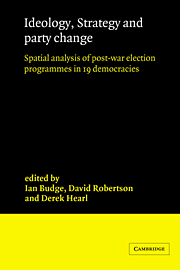 Ideology, Strategy and Party Change
Ideology, Strategy and Party Change Book contents
- Frontmatter
- Contents
- List of Tables
- List of Figures
- Preface
- 1 The influence of election programmes: Britain and Canada 1945–1979.
- 2 The internal analysis of election programmes.
- 3 Britain, Australia, New Zealand and the United States 1946–1981, an initial comparative analysis.
- 4 Canada 1945–1980: party platforms and campaign strategies.
- 5 Sri Lanka 1947–1977: elite programmes and mass politics.
- 6 Israel 1949–1981.
- 7 Ireland 1948–1981: issues, parties, strategies.
- 8 Northern Ireland 1921–1973: party manifestos and platforms.
- 9 Sweden and Denmark 1945–1982: election programmes in the Scandinavian setting.
- 10 The Netherlands 1946–1981.
- 11 Belgium 1946–1981.
- 12 Luxembourg 1945–1982: dimensions and strategies.
- 13 Austria 1945–1978.
- 14 Electoral programmes in West Germany 1949–1980: explorations in the nature of political controversy.
- 15 France 1958–1981: the strategy of joint government platforms.
- 16 Italy 1946–1979: ideological distances and party movements.
- 17 Japan 1960–1980: party programmes in elections.
- 18 Do parties differ, and how? Comparative discriminant and factor analyses.
- Appendices
- General bibliography
- Index
13 - Austria 1945–1978.
Published online by Cambridge University Press: 27 October 2009
- Frontmatter
- Contents
- List of Tables
- List of Figures
- Preface
- 1 The influence of election programmes: Britain and Canada 1945–1979.
- 2 The internal analysis of election programmes.
- 3 Britain, Australia, New Zealand and the United States 1946–1981, an initial comparative analysis.
- 4 Canada 1945–1980: party platforms and campaign strategies.
- 5 Sri Lanka 1947–1977: elite programmes and mass politics.
- 6 Israel 1949–1981.
- 7 Ireland 1948–1981: issues, parties, strategies.
- 8 Northern Ireland 1921–1973: party manifestos and platforms.
- 9 Sweden and Denmark 1945–1982: election programmes in the Scandinavian setting.
- 10 The Netherlands 1946–1981.
- 11 Belgium 1946–1981.
- 12 Luxembourg 1945–1982: dimensions and strategies.
- 13 Austria 1945–1978.
- 14 Electoral programmes in West Germany 1949–1980: explorations in the nature of political controversy.
- 15 France 1958–1981: the strategy of joint government platforms.
- 16 Italy 1946–1979: ideological distances and party movements.
- 17 Japan 1960–1980: party programmes in elections.
- 18 Do parties differ, and how? Comparative discriminant and factor analyses.
- Appendices
- General bibliography
- Index
Summary
POLITICAL PARTIES AND ELECTIONS SINCE 1945
Although contemporary Austrian politics seem remarkably peaceful, the predecessors of the three major parties were implacable opponents whose animosities caused the fall of the First Republic between 1934 and 1938. Their ideological Lager or ‘camps’ have influenced the thinking of present day parties. It is particularly appropriate therefore to study post-war party programmes to discover how and to what extent attitudes have come to resemble each other. It is also interesting to discover if the separation between parties remains the same in some areas while diminishing in others.
Of course the historical experience of civil war, collapse and external takeover itself affected the behaviour of parties in the post-war period. The formation of a Grand Coalition by the Socialists and the People's Party – so vital to political stability in Austria, and probably also to regaining independence – reflected the need to give at least two major political camps government responsibility.
The political parties that presently exist are the following (Pelinka 1981; Sully 1981):
The People's Party (Österreichische Volkspartei, ÖVP) is clearly the successor of the pre-war Christian-Social-Conservative camp. The Christian Socials as a party were moulded by political Catholicism (Diamont 1960) and – although the ÖVP claims to have made a new start in 1945 – its post-war development was again characterized by ties to Catholic associations.
[…]
- Type
- Chapter
- Information
- Ideology, Strategy and Party ChangeSpatial Analyses of Post-War Election Programmes in 19 Democracies, pp. 270 - 293Publisher: Cambridge University PressPrint publication year: 1987
- 5
- Cited by


